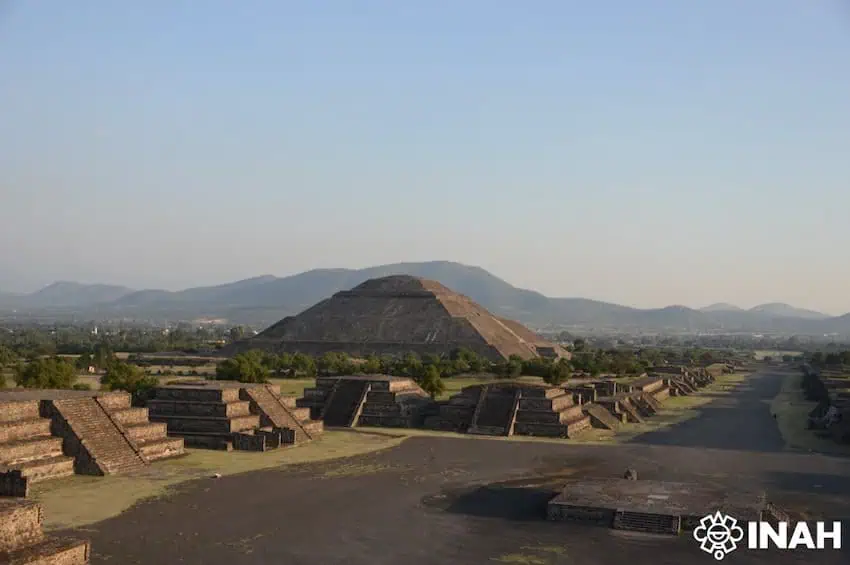In the beginning of times, when nothing was as we know it today, the gods gathered around the sun. When they all took their places, say the ancient scriptures, they sat and decided to create the world. Many attempts were made; many beings were created and destroyed. After many efforts, Quetzalcóatl, the feathered serpent god, set out to the underworld to talk to Mictlantecuhtli, the lord of the dead, who had the last bone in the cosmos, needed to create the perfect being.
They settled that the bone must be split in two, so that each of them could keep a part for themselves. Quetzalcóatl returned to the other gods with the coveted piece of bone, which they finally used to create the first human beings. In their honor, when several men and women were created, the newly born humans built a holy city. That was how, according to the Mexica who discovered the long-abandoned city when they migrated into Central Mexico, the magnificent Teotihuacán came to be.

The National Institute of Anthropology and History’s (INAH) records suggest that this archaeological site in present-day México state was constructed around the year 200 BCE. In the very beginning, farming communities occupied it and built its foundations. However, they quickly established commercial relationships with the neighboring towns, which eventually became the largest commercial network in Mesoamerica. Archaeological remains show that this interregional trade reached the Maya, and had major political influence in the Yucatán peninsula during the Preclassic and Classic Maya periods.
We don’t know what the inhabitants of Teotihuacán called themselves: the city’s name, translated as “where the gods were created” or “where men became gods,” was given to it by the Aztecs who found it 1000 years after its foundation. But the Teotihuacanos built the largest city in ancient Mesoamerica, the cultural region spanning from present-day central Mexico to Costa Rica. With an area of over 22 square kilometers, Teotihuacán “was one of the cultural centers of the region,” INAH authorities say, and had “stylistic and architectural influences” that reached the Maya in Guatemala and Honduras.
Why can’t people climb the pyramids anymore?
Mexicans today have a shared awe for the ruins of Teotihuacán. I first went to the site as a child, climbing the Pyramid of the Sun and crying in fear of falling when we had to go down the pyramid’s 238 steps.
Children today, sadly, will not have the same memories as I do. In 2020, INAH authorities announced a new prohibition: visitors would no longer be allowed to climb the structures in the complex.

“Neither the footwear nor the number of visitors (some days saw 15,000 visitors daily) were the same,” writes Alejandro Alcolea, journalist and editor of the scientific magazine Xataka México.
The decision was taken to preserve the ancient structures, as happened in other archaeological sites, like Chichén Itzá. Although the pyramids at Teotihuacán were largely reconstructed after excavation in the early 20th century, their preservation is a priority for the INAH, and visitor safety is a consideration as well.
Researchers and the press need special permission to take photos of the pyramid or conduct any activity on the structures. Heavy fines are meted out to those who violate these restrictions.
Depending on the severity of the conduct, fines span from 500 to 100,000 pesos depending on how badly the structure was damaged, and irreparable damage is punishable by jail time. Violators have also faced angry crowds: on March 20, a German visitor who climbed the Temple of Kukulkán in Chichén Itzá, Yucatán was booed and struck by other tourists who had gathered to watch the spring solstice at the complex before being taken into custody by National Guard officers.
You can still see Teotihuacán from up high
![]()
If you really want to see the Teotihuacán from above and aren’t afraid of heights, you still have options, namely a hot air balloon ride above the ruins. Nothing compares to the sight of the Teotihuacán valley at sunrise on a cold morning.
Prices start at 2,300 pesos, and you can enjoy the best panoramic view of the site. You can check out the packages and experiences at Tripadvisor, and choose whatever fits your needs best.
In any case, you have to be an early bird. The activities start early, and you are usually expected to be present at San Juan Teotihuacán at 5 a.m. The longest ride is about 3 hours long, but you can always choose shorter versions.
If you are taking the hot air balloon ride, come prepared! Mornings are usually chilly, so be advised to bring a jacket with you, and some sunblock, too, because the Sun is heavy as the day continues. As dawn breaks, you’ll surely get a glance at mighty Quetzalcoatl, soaring among the clouds.
Update: The Pyramid of the Moon has partially reopened to tourists since May 2025.
Andrea Fischer contributes to the features desk at Mexico News Daily. She has edited and written for National Geographic en Español and Muy Interesante México, and continues to be an advocate for anything that screams science. Or yoga. Or both.
